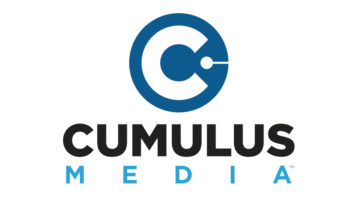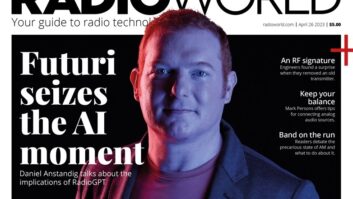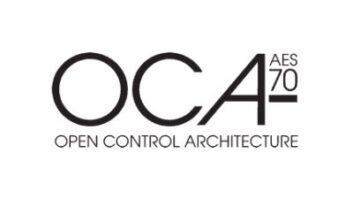IBOC Update – May 26, 2004
May 26, 2004 10:47 AM, By Mark Krieger, CBT

Index:
- DRM, the Other IBOC
- Omnia, Nautel Propose D-MPX Standard
- FCC Asked to Require Evidence of Non-Interference for Night AM IBOC Operation
- Susquehanna Converts Third in Indianapolis
- HD Radio Terminology
- DRS Demonstrates IBOC-capable FM Transmitter at NAB2004
To receive these articles twice a month in your e-mail, subscribe to the IBOC Update – Insight on HD Radio e-newsletter. Click here to subscribe.
NewsDRM, the Other IBOCAmplitude modulation, the workhorse of LW, MW and SW broadcasting for nearly a century, has long been subjected to attempts to improve its performance using specialized analog techniques — most of which have never quite met expectations. Even so, years of research and development in AM MW/SW digital transmission now promise to change perceptions about these narrow bandwidth radio broadcast mediums. The fruition of those efforts is manifested in two similar, yet distinctly different AM digital broadcast technologies: Ibiquty’s AM HD Radio, designed primarily around the needs of U.S. broadcasters, and Digital Radio Mondiale’s (DRM) systems multiple implementation approach. While the Ibiquity system has received most of the attention in the states, DRM has been building support worldwide as a replacement technology for both international and domestic broadcasters overseas.DRM was first conceived as a replacement for AM broadcasting below 30MHz in 1998 by a consortium of world broadcast organizations, which has since expanded to include 81 members, including American broadcast manufacturers Harris, Broadcast Electronics and DRS Broadcast Technology. Unlike the HD Radio AM IBOC digital system developed and licensed by Ibiquity, DRM encompasses a non-proprietary system architecture available to broadcasters and manufacturers alike.Because channel bandwidth, emission mask requirements, and propagation vary with different regions and bands, four modes of operation are specified for DRM, offering greater levels of signal robustness in exchange for lower audio data rates. Like HD Radio AM, DRM can be transmitted in a hybrid (digital/analog simulcast) mode but with only with a significantly lower data rate than in its purely digital implementation, which offers a maximum audio data rate of about 24kb/s. Even at this level, DRM does not match Ibiquity’s ability to deliver up to 36kb/s of AM audio data, but that comparison is shadowed by lingering spectral mask issues surrounding US adoption of AM HD Radio. Fraunhofer, an authoritative developer of advanced audio coding technologies, is a DRM member and has tailored the system’s audio compression scheme, a variant of its AAC codec, for optimized mono audio performance.Regardless of its less glamorous audio bit rate, DRM’s acceptance around the world seems to be gathering momentum. In particular, international SW broadcasters — including the U.S. based National Association of Shortwave Broadcasters — have enthusiastically endorsed its rollout and are actively promoting its development. The same is true of some many medium wave broadcast services. In Asia, both China and Thailand have endorsed the use of DRM as a replacement for existing AM MW services, as has the Asia-Pacific Broadcast Union. And in the Middle East, the Arab States Broadcasting Union has become a leading proponent of the system.On the receiver end of the equation, Mayah is now delivering its DRM 2010 receiver, while Sangean America expects to release a DRM-compatible product within the year. But the biggest boost for IBOC below 30MHz comes with continued development of DSP-based receivers that are easily adaptable to new modulation and coding schemes through software updates. Such receivers promise to demolish the multiple-standards barrier facing consumer electronics producers. In fact, it’s likely that some companies will soon offer software based radios compatible not only with multiple DRM modes, but Ibiquity’s AM HD Radio and satellite radio services as well.Exactly how AM IBOC will ultimately manifest itself in every nation is still in question. Yet it seems clear that DRM is well positioned to become a world leader in narrowband DAB.Technology/ApplicationsOmnia, Nautel Propose D-MPX StandardAn innovative industry solution to digital connectivity issues in the FM broadcast chain was the subject of a joint white paper presented by Nautel’s Scott Martin and Omnia Audio’s Frank Foti at the April NAB2004 convention. Entitled Enhancing the Digital Path: Digital Multiplex (D-MPX) Connectivity the technical paper deals with problems faced when trying to interface high performance digital exciters and audio processors. According to the authors — both noted for their respective expertise in FM exciter and processor design — many of the performance advantages offered by state-of-the-art digital signal processing and modulation techniques are frequently lost due to sample rate conversion and/or unnecessary transformations between the digital and analog realm.The issues outlined in the paper are not new, as many broadcast engineers involved in the pursuit of high performance analog FM can attest. In fact, the introduction of digital FM exciters and audio processors in the early to mid 1990’s spurred considerable controversy in engineering circles regarding compatibility between different brands of digital equipment in a station’s air chain. The most frequent complaint among engineers attempting to “marry” digital processors and exciters is the presence of modulation overshoots and subtle distortion caused by sample rate conversion necessitated by different equipment designs.The long-awaited solution is being developed as a joint technology demonstrator that will establish a non-proprietary standard for an FM MPX composite digital baseband signal, according to Omnia’s Frank Foti. The interface uses standardized communication protocols and Ethernet-style connectivity through the use of RJ45 jacks and CAT-5 cabling, thus avoiding the need to convert signals to the unbalanced analog composite signal that remains the lowest common denominator for connectivity between high performance digital audio processor/stereo generators and contemporary digital exciters. Nautel and Omnia are said to be intent on demonstrating a prototype chain employing the new interface on-air in a major U.S. market in the near future.Achieving the highest degree of analog FM signal integrity is of critical importance to stations engaged in the conversion to hybrid FM IBOC DAB. Because all FM HD Radio equipped receivers “blend” back and forth between the analog stereo and digital stereo signals, it is vital that the analog signal is not only perfectly time-aligned with the digital signal, but is also needs to be of the highest quality to minimize listener distraction. A D-MPX standard will also make it easier for manufacturers to build the required FM IBOC digital/analog time alignment function into processors, thus allowing for more flexible and redundant air chains.Broadcast manufacturers such as Broadcast Electronics and Eddystone have openly expressed interest in the project, while other companies are said to be monitoring developments closely.FCC UpdateFCC Asked to Require Evidence of Non-Interference for Night AM IBOC OperationIn response to the FCC’s April 15 Final Notice of Proposed Rulemaking (FNPRM) regarding digital audio broadcasting (DAB), Reunion Broadcasting, an owner/operator of several AM broadcast stations, has requested that the FCC approve AM IBOC night operation, but only if licensees can clearly demonstrate that such operation will “fit the Commission’s allocation scheme.”In making the case for a technical showing of no increase in interference, Reunion suggests that the digital carrier power present in an AM IBOC station’s first-adjacent channel can be measured with a degree of certainty and may therefore be subjected to a standard root-sum-square (RSS) analysis as detailed in the existing AM rules. Reunion goes on to recommend that the Commission require that the digital sideband energy be reduced to whatever level required to assure signals meets existing protection requirements.Reunion’s comments are significant because they reflect a growing desire among AM broadcasters to quantify potential IBOC AM interference issues and spell out exactly how they will be addressed. Recent reports indicate that some AM IBOC operators have voluntarily discontinued hybrid operation due to interference complaints, and await a final rulemaking to see what the FCC’s final position will be. This desire for a definitive set of procedures is at odds with the position taken by the NAB Radio Board on January 20, which urged the FCC to permit night operation of AM IBOC DAB unconditionally, with interference issues to be dealt with on a case by case basis.More comments regarding AM IBOC DAB are expected in filings with the FCC in coming weeks.Eye on IBOCSusquehanna Converts Third in IndianapolisWGRL-FM recently became the third Susquehanna FM in Indianapolis to implement HD Radio technology. The ’80s format station went on the air with a BE HD Radio FMi-703 transmitter, FXi exciter and FSi 10 generator in May, following the conversion of Indianapolis sister stations WFMS-FM and WGLD-FM in December 2003.”There was an audible difference the minute we put it on the air,” said Susquehanna’s Indianapolis regional engineering manager Max Turner, who reported no multipath on the digital channel and exceptional signal strength overall. “We had a listener write in from a nearby town; he had an HD Radio receiver and noticed we had HD Radio on two of our stations already.”WGRL is the seventh Susquehanna Radio station to commence HD Radio operations. The 33-station group has already installed BE HD Radio transmitters in Atlanta, Cincinnati and York, PA.All seven stations are configured for low-level combiner amplification. Susquehanna is completing all the low-level combines as phase one of its HD Radio implementation.HD Radio TerminologyAn Introduction to the New Language Surrounding HD RadioIPM: incidental phase modulation. An undesirable phenomenon occurring in some AM transmitters, where the relative phase of the carrier unintentionally varies with modulation. This characteristic is of little concern when transmitting a monaural AM analog signal, but becomes a critical parameter where analog AM stereo or any type of AM digital transmission is involved.BPSK: binary phase shift keying. The modulation technique used to carry digital information within AM HD Radio’s reference carrier. Data is impressed on the carrier by alternating its relative phase between two states. This is one reason that AM transmitters must have extremely low levels of IPM if they are to pass an IBOC digital signal satisfactorily.ProductsDRS Demonstrates IBOC-capable FM Transmitter at NAB2004DRS Broadcast Technology, current manufacturer of the Continental Electronics family of transmitters, demonstrated its 815 D production model, solid-state 5kW FM transmitter at NAB2004, but with an interesting twist. Through fine linearization of the transmitter’s amplifier stages, the 815 D was able to successfully transmit a low-level combined FM HD Radio hybrid signal at 4kW without significant physical modifications — a clear demonstration of the transmitter’s wideband characteristics. The transmitter’s physical design features both front panel hot-swappable PA modules along with a rollout rear drawer that allows easy access to the transmitter’s splitter and combiner subassembly.According to DRS’ Dave Hultsman, the current 815 D production model is designed only for analog operation, but will serve as a template for final development of an 815 HD model to be released later this year.












